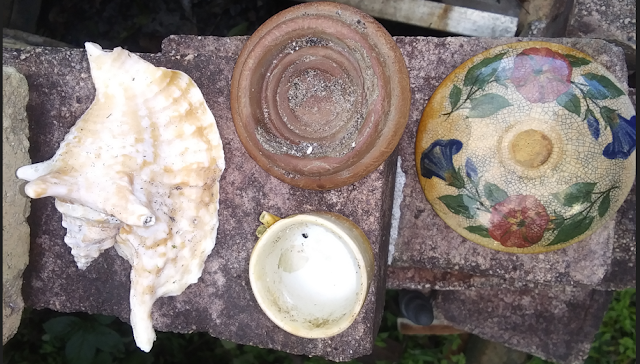Written by the TreasureGuide for the exclusive use of the Treasure Beaches Report.
 |
| Penslar Bottle Find New Year's Eve. |
On New Year's Eve I took a little walk and picked up the above bottle that is embossed Penslar. The Penslar Chemical Company of Detroit, MI operated from 1907-1965 and sold pills, salves, lotions and toiletries. I think this is the first Penslar bottle I found.
As I said above, I took a little walk yesterday, mostly to look for bottles but whatever interesting things might pop up. I noticed one area where the water created what looked very much like a paved path. Crushed coral and shells were tightly packed along the water line and formed a very firm walking path along the water's edge. It was just the natural process of water classifying and depositing similar materials. It very much reminded me of the hard white layer I found exposed on the beach after Nicole. Unfortunately, I didn't take my camera yesterday. It looked like there was a lot of hard dredged up material nearby that was used as fill some time ago and recently washed out.
 |
| Iron Glue Bottle, Lead Object, and Clear Lens. |
Above is a photo of three more things I picked up. I don't know what kind of lens that is. Maybe from a telescope or survey instrument. I couldn't find any markings on it.
The lead object is another one of those lead objects that I've talked about before. I did several posts on those lead objects, which I've seen referred to as styli in some archaeological articles. More recently I heard from one archaeologist overseas that they could be net weights. See Treasure Beaches Report: Pt. 2. (2020 and Beyond). : 9/21/22 Report - Finds. Researching Lead Objects: Pencils or Styli(?) Bigger Surf Coming Thursday and Friday. (tbr2020.blogspot.com) and Treasure Beaches Report: Pt. 2. (2020 and Beyond). : 11/14/22 Report - Some recent Treasure Coast Finds: Lead Items. Beaches After Nicole. (tbr2020.blogspot.com).
I've found at least five of these lead objects now and examined four found by Russ P. Of my examples, this is the first that I did not find on a shipwreck beach. It was found along with what appeared to be a lot of the old, dredged material that I mentioned above. When searching shoreline areas, we do not find things in context, nicely layered according to time periods. It is therefore more difficult to figure it all out. As I've said before, the lead objects found by Russ, while looking very much like my own, being made of lead and being of similar size and shape, are a little different than mine. Those found by Russ have more blunt ends, for example. I'm still trying to figure out what they are.
Here are just a few more items I picked up yesterday. Nothing good but small pieces of the history of the area.
 |
| Seashell, Pottery Object, Child's Play Teacup. and Painted Floral Top. |
 |
| Adolphus Busch Hand Blown Bottle With Big Bubbles and Badly Damaged Lip. |
 |
| S B & G Co. Marking On Bottom of Same Bottle. |
- S.B.& G.CO…………………….Streator Bottle & Glass Company, Streator, Illinois (1881-1905). The Streator plant eventually became part of the American Bottle Company, then later Owens Bottle Company, and finally part of the Owens Illinois Glass Company (Plant #9). “S.B.& G.CO.” is one of the most commonly seen marks on handblown beer bottles from the late 1800s and early 1900s. Many, many private brewers and bottlers from the Midwest and eastern United States had bottles specially made for them by Streator. The mark is also seen on other bottles of the period, including pickle bottles, soda bottles and other containers. (From Glassbottlemarks.com)
---
As usual, the blog readers came through. Three people identified the mystery item I recently posted. A picture of a similar item was found on eBay by.G Shelt, DJ, and Mitch K. The item was listed on eBay as a "Cast Iron Improved Keystone Barn Hay Trolley Rolling Door Piece Oct 16, 1866”.
So what was a hay trolley door piece doing in an area where I previously dug hundreds of railroad spikes and items that showed signs of being the site of a derailing? Just like with shipwrecks, things can get confusing. Typically used to move hay bales into barns, was the item found where it was previously used for agriculture, or was the item being transported or used by the railroad, or was it found out of context? Right now, I am leaning towards the second, because I have found a few agricultural items in the area, although any of the explanations are possible. It was found very close to other railroad items and items I associated with the suspected railroad derailing, but I've also found a few other agricultural items in the area and have long suspected the area was also an agricultural area. Time periods and events overlap. Some items could be either agricultural or railroad related, ie. the several long-handle tin drinking cups and the scythe blades. The blades were stored tightly in a location and manner that suggested to me that they were railroad related, although I can't prove that. The railroad sledgehammer heads were buried very close to and in a very similar manner to the railroad sledgehammer heads. The interesting thing about all this for me is the archaeology of it and how finds provide evidence that leads to hypothesizing and eventually to a solution.
Thanks to those who provided the answer to my mystery find.
---
Wishing you a happy, healthy and prosperous new year.
Treasureguide@comcast.net